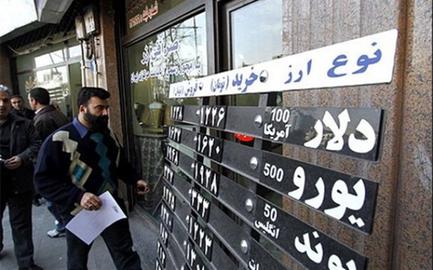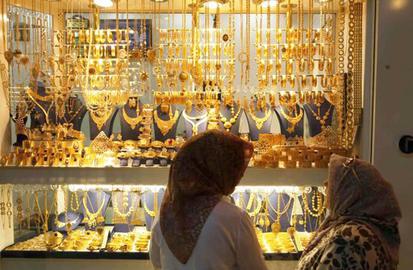As the Persian calendar year 1396 comes to an end and Iranians and millions of others prepare to celebrate another Norooz, analysts consider the future of Iran’s economy. But, as the future of the Joint Comprehensive Plan of Action (JCPOA) comes under threat from the Trump administration, Iran’s currency exchange markets face turmoil and the Iranian rial declines, the economy seems to be even more uncertain than it did at this time last year. Iranians will usher in 1397 with many questions on their minds.
Currency Exchange
When the exchange rate for the US Dollar (USD) versus the Iran Rial (IRR) surpassed 50,000 IRR per USD, it did little to bolster the Iranian public mood. The euro exchange rate increased even more dramatically, reaching 62,300 IRR per EUR — marking a 50 percent appreciation against the IRR. The Central Bank of Iran (CBI) was forced to intervene in the market, injecting hard currencies and further regulating the market. Iranian police officers joined in the drama by arresting currency dealers and rounding up small-time black market operatives. Soon after, the currency markets stabilized and IRR/USD rate shed 5,000 rials. As a result, the Iranian people formed long lines outside official currency exchange offices to convert their hard-earned savings to hard currencies. Some have been unable to find the dollars they need, even if they offer up a passport with a visa stamp and travel documents, which would normally make access to dollars easier. Valiollah Seif, the governor of the Central Bank of Iran, has concluded there is no valid economic reason to explain the trends in currency exchange markets, and confirmed that expectations of further economic turmoil have led to an insatiable demand for hard currency.
As the Iranian New Year approaches, analysts observe that the gap between the official exchange rates and market exchange rates is increasing. This has provided many officials, whether in charge of public projects or government-owned companies, with a golden opportunity for personal gains. Many with access to hard currency at the official rate do not hesitate to sell their currency allocations on the market to pocket the difference.
Given the current economic policies, many people expect the multiple rates for currency to remain in place. Bamdad Economic Studies Institute, a non-government think tank, predicts the USD exchange rate in Tehran will reach 56,500 IRR to the USD in the new year. And there is little incentive among Iran’s rent-seeking policy-makers to change anything in this market.
Gold
In addition to hard currency, there is the market for gold and precious metals. Gold prices and currency exchange rates have a correlation of .88 in Iran, based on studies conducted by various organizations. This is in part because of the gold prices on the international market and in part because Iranians save in gold coins and have done since ancient times. When the IRR begins to lose its value, the demand for gold and gold coins picks up. As the IRR was in decline last February, gold prices began to rise in Tehran. The Central Bank of Iran tried to push gold prices down prices by offering to sell freshly minted gold coins. Its secondary objective was to relieve pressure on hard currencies by offering consumers an alternative to save.
In the first four days of the first offering, the CBI sold 43,000 pieces of gold coins, bringing in 430 billion rials from private individuals, roughly 80 million USD worth of cash. In the first two days of the second offering, the CBI sold 75,000 pieces of gold coins, collecting 1,000 billion rial from consumers. In other words, in two separate offerings, the CBI replaced between 280 million and 300 million USD worth of cash with gold receipts. But the success was temporary. Gold prices were stable for a few weeks, but then began to rise. The power of expectations is strong in this market. With the global markets forecasting a price of 1,450 USD per ounce for gold, Iranians are keen to increase their gold holdings.
Stock Exchange Market
The Persian year 1396 was not a bad year for the Tehran Stock Exchange (TSE). From March 2017 to February 2018, its index increased 26 percent, a significant return on investment to traders and small-time investors. The rising global prices for oil, minerals and petrochemical products increase Iranian companies’ profits, while the declining IRR adds to their comparative advantages when exporting their products. As the currency market was heating up, the TSE index went up, adding to investors’ gains. However, with increased uncertainty, the TSE’s prospects for further growth diminish. First of all, when predicting companies’ future performances, investors cannot use a solid currency exchange rate for more than a day or possibly a week. Many investors use daily estimates to make decisions and these estimates can vary wildly from day to day. This means the TSE witnesses week-long ups and downs and investors rush to make adjustments within minutes, amplifying the changes and adding even greater volatility.
The possible return of sanctions make the future more unreliable and bleak, since Iranian businesses will lose their export markets and their revenues if sanctions are re-imposed. Under this increased uncertainty and risky future, Iranian banks will emerge as more reliable choice for saving if they promise a fixed return when compared to savings in the stock market.
Monetary Institutions
The Iranian government’s main challenge over the last 12 months came from within the country’s financial system. As unlicensed financial institutions and credit unions collapsed, they defaulted on their promises. Thousands of deposit holders were robbed of their money, and no one was available to answer their questions. What unfolded amounted to a multi-billion dollar swindle worthy of the history books — and no one was prosecuted. Instead, deposit holders, encouraged by those responsible, pressured the Central Bank of Iran (CBI) to compensate them for their losses. They claimed that, as the regulatory body, the CBI was responsible. The CBI had to address the aftershocks by transferring liabilities to public and private banks, which took over the failed enterprises. And, as the new year approaches, Iranian banks are under more stress than ever: Their resources are allocated based on political necessities and priorities and their profit margins are non-existent. They absorb the cost of bad policies and rampant cronyism, while economic growth slows down.
Housing Market
In March 2017, many people were hopeful that Iran’s housing market was finally coming out of a four-year long recession. In April 2017, the CBI reported a modest 3.5 percent increase in average prices and a notable 8.5 percent decline in the number of sales, known as the sales volume. In May 2017, the CBI registered a 4.6 percent increase in sales volume, as well as a 5.7 percent increase in average prices. The equilibrium was moving, with both the demand for and supply of housing shifting. The average house prices continued to grow throughout summer 2017, but the sales volume, although higher than a year earlier, showed month-to-month ups and downs. The recession in the housing market remained persistent, although subdued. Comparing winter 2018 and winter 2017, the average house price increased by 20.5 percent, but the sales volumes showed a very modest increase, if any. This is an indication of a decline in housing inventory, and not a sustainable increase in demand.
In the new year, the housing market will be influenced by changes in currency markets and gold prices. Demand might increase if Iranian banks expand their mortgage programs, which is unlikely given their heavy burden of liabilities. Thus, nobody expects a sudden increase in housing prices, while many expect the prices to increase modestly and proportionally to inflation.
Economic Growth
The International Monetary Fund estimates Iran has had an economic growth rate of 3.5 percent over the last 12 months, much lower than the 12.5 percent increase over the 2016-2017 period. Iran’s economy grew at a pace similar to global economic growth from 2017 to 2018. Its growth rate was higher than the average economic growth rate for developed countries — 2.2. percent — but less than the 4.6 percent growth rate for countries with emerging markets. Analysts, speaking to Mehr News Agency, predicted that the final tally for the period from March 2017 to February 2018 will be 4.6 percent.
The final reports paint a somewhat optimistic picture of Iran’s economic performance in the Persian calendar year 1396. The agriculture sector grew by 8.3 percent, oil by 3.1 percent and industries by 6.4 percent. Iran’s service sector set the highest growth, at 9.5 percent. The construction sector shrank by 2.4 percent, confirming a decrease in the supply of housing. As Iran’s international position evolves, its economic growth will be decided by changes in its foreign trade.
Overall, as the year ended in Tehran, many Iranians have noted the challenges ahead. They use their experience from previous upheavals to prepare themselves for the future. Their banks are less reliable than before, their currency is subject to sudden drops and their economy is facing fresh threats of sanctions. Few will venture to start new businesses or to make major investments under such conditions. At the same time, policy makers in Tehran are growing weary of another source of volatility. In January Iranians took to streets to express their dissatisfaction with the current economic affairs. And Masoud Nili, President Rouhani’s chief economic advisor, warned in an interview recently: “We are going through a very narrow pass, facing economic super challenges”. With this in mind, the Iranian New Year certainly promises to be a thrilling one.
visit the accountability section
In this section of Iran Wire, you can contact the officials and launch your campaign for various problems



























comments